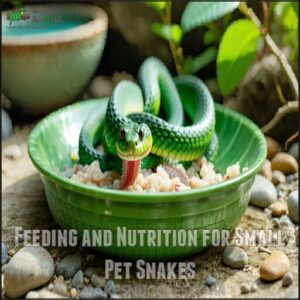This site is supported by our readers. We may earn a commission, at no cost to you, if you purchase through links.

These pint-sized reptiles are perfect for first-time snake owners. They’re manageable, low-maintenance, and surprisingly docile.
Rosy boas, in particular, max out around 2-3 feet and come in stunning color variations. They’re gentle, don’t require massive enclosures, and are relatively easy to feed.
Ball pythons, while slightly larger, are known for their calm temperament and compact size. Both species offer an excellent introduction to snake ownership, providing all the excitement of reptile keeping without overwhelming you.
Ready to meet your scaly new friend?
Table Of Contents
- Key Takeaways
- Choosing The Smallest Pet Snake
- Benefits of Keeping Small Pet Snakes
- Small Snake Care and Housing
- Feeding and Nutrition for Small Pet Snakes
- Handling and Health of Small Pet Snakes
- Frequently Asked Questions (FAQs)
- What’s the smallest pet snake you can have?
- What small snake is a good pet?
- What is the friendliest snake as a pet?
- What is the most cuddly pet snake?
- What’s the smallest snake you can have as a pet?
- What snake can live in a 20 gallon tank?
- Are small snakes suitable for children?
- How do you clean a snakes enclosure?
- Do small snakes require special humidity levels?
- Are there any known small snake health issues?
- Conclusion
Key Takeaways
- You’ll find rosy boas and ball pythons are top choices for smallest pet snakes, rarely growing beyond 3-4 feet and offering an excellent introduction to snake ownership.
- You’ll need to create a precise habitat with proper temperature gradients (85-90°F warm zones, 75-80°F cool zones), appropriate humidity (50-60%), and secure enclosures to keep your tiny snake healthy and safe.
- You’ll want to master feeding with careful portion control, matching prey size to your snake’s length and monitoring weight regularly to prevent overfeeding or underfeeding.
- You’ll need to learn gentle handling techniques, using slow movements and supporting your snake’s body to build trust and minimize stress, while also staying alert to potential health issues like parasites or respiratory infections.
Choosing The Smallest Pet Snake
If you’re a beginner looking to enter the realm of snake ownership, choosing a tiny reptilian companion can be an exciting and manageable adventure.
Tiny snakes, big personalities: Your perfect reptilian companion awaits, ready to slither into your heart!
With species ranging from the miniature Barbados Threadsnake to the compact Rosy Boa, you’ll find the perfect pint-sized pet that fits your lifestyle and experience level.
Popular Small Snake Species for Pets
If you’re looking for a small snake that packs a big personality, you’re in luck! Several tiny reptile companions are perfect for first-time snake owners.
- Ball Pythons shine with colorful morphs and stay compact at 3-4 feet
- Corn Snakes offer a gentle temperament and remarkable adaptability
- Rosy Boas rarely exceed 3 feet and boast exceptional docility
- Western Hognose Snakes capture hearts with their quirky upturned snouts
- Kenyan Sand Boas thrive in small spaces, rarely growing beyond 2 feet
These smallest pet snake breeds prove that good things truly come in small packages. Each species brings unique characteristics that make them ideal beginner snake pets.
Whether you’re tight on space or new to reptile ownership, these small snake breeds offer a fascinating entry into serpent companionship. Their manageable size, docile nature, and low-maintenance requirements make them the perfect introduction to snake keeping, within the sphere of reptile care.
Factors to Consider When Selecting a Small Snake
Exploring smallest pet snakes requires careful consideration of key factors that’ll shape your reptilian relationship. Your snake’s temperament matters more than size—some tiny breeds are docile and perfect for beginners, while others demand experienced handling.
Consider lifespan expectations, with some small snakes living over 25 years, making them long-term companions. Assess enclosure size needs, feeding preferences, and beginner suitability.
The right small snake isn’t just about being tiny; it’s about finding a scaly friend that fits your lifestyle and care capabilities. Many factors influence tiny snake care tips, including habitat and nutrition.
Researching The Best Small Snake for Beginners
Serpent seekers, your reptilian adventure starts here! When researching the smallest pet snake for beginners, you’ll want to zero in on species that match your lifestyle and experience level.
- Consider beginner-friendly species like corn snakes and rosy boas
- Evaluate each snake’s temperament and handling characteristics
- Assess initial costs and long-term care requirements
Choose wisely, and your tiny companion will be your perfect scaled sidekick, providing a unique opportunity for a reptilian adventure.
Understanding The Needs of Small Pet Snakes
Because small snakes have unique care requirements, you’ll need to dive deep into their specific needs.
Understanding small snake behavior, habitat preferences, and diet is essential for creating a thriving environment.
Focus on precise temperature gradients, proper enclosure enrichment, and gentle handling techniques to guarantee your tiny reptilian companion stays healthy and content.
Benefits of Keeping Small Pet Snakes
If you’re looking for a low-maintenance, space-saving pet that won’t break the bank, small pet snakes might be your perfect reptilian companion.
These tiny serpents offer an exciting , manageable pet experience with minimal hassle, making them an ideal choice for beginners and reptile enthusiasts alike.
Space-Saving Enclosures for Small Snakes
Your miniature snake’s domain matters more than you might think! Compact enclosures with vertical spaces make perfect habitats for tiny reptiles.
Select tanks matching your snake’s dimensions, ensuring secure lids and cozy hideaways. Consider the species-specific needs when selecting an enclosure.
- Maximize limited space creatively
- Create a snake sanctuary
- Design with precision
- Embrace minimalist reptile living
Easy-to-clean setups keep your pet healthy and happy, which is crucial for a happy and healthy pet.
Affordable Care and Feeding Requirements
Your wallet will breathe easy with small snake ownership.
Snag frozen prey in bulk to trim food costs. Budget-friendly enclosures and affordable substrates like aspen shavings keep expenses low.
Precise feeding schedules prevent waste and overfeeding. By strategically sourcing supplies and understanding snake diet basics, you’ll manage care without breaking the bank, and this is a key aspect of budget-friendly ownership.
Low Maintenance and Easy Handling
If you’re looking for a pet that won’t demand constant attention, tiny pet snakes are your perfect match.
These docile snake breeds require minimal handling, making them ideal for busy pet owners.
With simple care routines and low-stress maintenance, you’ll find snake handling a breeze.
Their compact size means easy enclosure cleaning and straightforward health monitoring – perfect for first-time reptile enthusiasts.
Variety of Small Snake Species to Choose From
In the realm of small snake species, you’ve got a treasure trove of exotic companions to explore.
From the docile corn snake to the quirky western hognose, these tiny reptiles offer unique personalities:
- Rosy boas with their gentle demeanor
- Corn snakes sporting vibrant color morphs
- Kenyan sand boas blending perfectly with desert landscapes
- Western hognose with their adorable upturned snouts
Dive into the best small pet snake breeds to explore these fascinating creatures and discover the joy of having a tiny reptile as a companion.
Small Snake Care and Housing
You’ve chosen a tiny snake companion, so get ready to create the perfect home for your new scaled friend.
When setting up your snake’s habitat, you’ll need to focus on key elements like secure enclosures, precise temperature control, and comfortable substrate that mimics their natural environment, ensuring a perfect blend of secure conditions for your pet.
Setting Up an Escape-Proof Enclosure
Every savvy snake owner knows an escape-proof enclosure is your first line of defense.
Choose Enclosure Materials with secure, locking lids that create a Fort Knox for your tiny reptilian friend.
Prioritize ventilation design with fine mesh screening and confirm the habitat’s size matches your snake’s needs.
Small snake escape prevention isn’t just smart—it’s essential for keeping your slithery companion safe.
A properly designed setup, like an escape-proof terrarium setup, is critical for the snake’s well-being.
Creating a Suitable Environment for Small Snakes
Set up your small snake’s habitat by crafting a snug, escape-proof enclosure that mimics their natural environment.
Choose soft substrates like aspen or cypress mulch to create a comfortable base. Add strategic hiding spots to provide security and environmental enrichment, transforming a simple snake enclosure into a thriving, stress-free habitat that’ll make your tiny reptile feel right at home.
Proper enclosure size matters greatly for their well-being.
Temperature Gradients and Lighting Requirements
After perfecting your snake’s habitat layout, master its thermal blueprint. Your scaly friend needs a carefully crafted temperature landscape that mimics natural environments.
Craft a cozy snake sanctuary with precision, transforming an enclosure into a perfect reptilian paradise.
- Warm Zones: Create a basking spot between 85-90°F using strategic heat lamps.
- Cool Zones: Maintain a comfortable 75-80°F range for temperature variety.
- Light Cycle: Implement a 12-hour day/night rhythm with gentle UVB lighting.
Thermostats are your secret weapon, transforming an ordinary enclosure into a snake’s paradise.
Humidity and Substrate Options for Small Snakes
Your snake’s comfort hinges on the right substrate and humidity levels.
After nailing those temperature gradients, focus on creating a moisture-perfect habitat. Opt for cypress mulch or coconut fiber, maintaining 50-60% humidity.
A shallow water bowl helps regulate moisture. Monitor humidity levels closely—your tiny reptile friend will thank you with vibrant health and a thriving demeanor.
For ideal results, consider coconut fiber options available to create an optimal environment with the right humidity levels and coconut fiber.
Feeding and Nutrition for Small Pet Snakes
When you bring home a tiny pet snake, you’ll need to master the art of feeding these miniature reptiles with precision and care.
Your snake’s nutrition depends on understanding its unique dietary needs, portion sizes, and feeding schedule to keep your new scaled companion healthy and thriving.
Feeding Schedules and Portion Control
With your small snake’s cozy home ready, mastering feeding becomes your next adventure.
Here’s a smart approach to nourishing your tiny reptilian friend:
- Match prey size to snake length
- Track feeding frequency carefully
- Use frozen prey for safety
- Monitor snake’s weight regularly
Precise portions prevent overfeeding while keeping your slithery companion healthy and happy.
Supplements and Vitamins for Small Snakes
When nurturing your tiny serpent friend, understanding supplements can be a game-changer.
Most small snakes don’t need extensive vitamin regimens, but targeted nutrition matters.
| Supplement | Purpose | Frequency |
|---|---|---|
| Calcium | Bone Health | Weekly |
| Vitamin D3 | Nutrient Absorption | Periodic |
| Multivitamin | Overall Wellness | Rare |
Strategically dusting prey with calcium powder prevents vitamin deficiencies, supporting your snake’s growth and maintaining peak health.
The key is moderation and precision in supplementation.
Avoiding Overfeeding and Underfeeding
After fine-tuning your snake’s diet with supplements, you’ll want to master feeding precision.
Weight is your roadmap to healthy nutrition.
Here’s your feeding game plan:
- Match prey size to your snake’s midsection
- Monitor weight regularly
- Adjust frequency with age and growth
- Prevent overfeeding through careful portioning
- Use frozen prey for safety and convenience
To avoid health issues, consider feeding frequency guidelines.
Your snake’s health hinges on hitting the nutritional sweet spot and maintaining a healthy nutrition plan through careful portioning.
Handling and Health of Small Pet Snakes
When you’re caring for a small pet snake, gentle handling and keen health awareness are your most important tools for maintaining a happy, thriving reptilian companion.
You’ll want to learn specific techniques that minimize stress and recognize early warning signs of potential health issues to guarantee your tiny snake stays healthy and comfortable.
Safe Handling Techniques for Small Snakes
After mastering feeding routines, you’ll want to confidently handle your tiny reptilian friend.
Gentle handling transforms your relationship with a small pet snake, turning potential nervousness into mutual trust.
A snake hook becomes your best ally, helping you guide and support your slithery companion without sudden movements.
- Feel the excitement of building a bond with your docile pet
- Experience the thrill of careful, controlled interaction
- Discover the joy of becoming a confident snake handler
Your handling technique matters most.
Always support your snake’s body, move slowly, and watch for subtle body language cues.
Frequent, short handling sessions help your snake become comfortable with you.
Pro tip: Wash your hands before and after handling to prevent stress and maintain hygiene.
Remember, patience isn’t just a virtue—it’s your secret weapon in creating a calm, trusting connection with your small snake.
To guarantee safety, consider using a small snake handling kit for beginners.
This will help you ensure a safe and enjoyable experience for both you and your pet.
Recognizing Signs of Stress and Illness
When your scaly friend seems off, pay attention.
Snake stress indicators like reduced appetite, lethargy, or unusual hiding can signal underlying health issues.
Watch for changes in behavior or physical appearance that might suggest illness symptoms.
Regular monitoring helps catch potential problems early.
If you notice persistent abnormal signs, it’s time to consult a reptile veterinarian.
Quick action can prevent minor health concerns from becoming serious snake health complications, and this is crucial for the well-being of your pet.
Common Health Issues in Small Pet Snakes
When caring for small pet snakes, watching for common health issues is essential.
Keep an eye out for potential problems that can impact their well-being:
- Parasites that silently drain your snake’s energy
- 裸 Respiratory infections threatening their delicate breathing
- Digestive problems disrupting their fragile health
Monitor for signs of mites, regurgitation, and skin infections to confirm your tiny reptile companion stays healthy and thrives.
Veterinary Care and Emergency Procedures
After spotting health quirks in your snake, knowing when to seek professional help becomes your superpower.
Finding reptile vets isn’t just smart—it’s survival 101. Keep an emergency contact list handy, and learn basic snake emergency first aid.
Watch for illness signs like unusual lethargy, appetite changes, or weird skin discoloration. Your quick response can mean the difference between a minor hiccup and a major health crisis.
When in doubt, call a professional who understands snake veterinary care. This action can be crucial, making it a key part of emergency first aid.
Frequently Asked Questions (FAQs)
What’s the smallest pet snake you can have?
Like a tiny thread weaving through nature’s tapestry, the Barbados Threadsnake is your miniature reptilian companion.
At just 4 inches long, it’s the world’s smallest snake—perfect for those wanting a petite, low-maintenance pet that fits in the palm of your hand.
What small snake is a good pet?
You’ll love the Rosy Boa as a pet snake.
They’re small, docile, and easy to handle. Growing up to 34 inches, they’re perfect for beginners.
Their calm nature and manageable size make them an ideal first snake companion.
What is the friendliest snake as a pet?
Ever watch a puppy melt hearts?
Ball pythons are the reptile world’s teddy bears—docile, calm, and incredibly gentle.
They’ll curl up in your hands, making them the friendliest snake companion you could welcome home.
What is the most cuddly pet snake?
You’ll find ball pythons top the cuddly snake chart.
They’re known for their gentle nature, enjoying calm handling and often curling up comfortably against your body.
Making them the most snuggly serpent companions for reptile enthusiasts.
What’s the smallest snake you can have as a pet?
You’ll want the Barbados Threadsnake, measuring just 4 inches long.
This tiny, gentle reptile fits in your palm, requires minimal space, and makes an incredible pocket-sized companion for snake enthusiasts seeking the ultimate miniature pet.
What snake can live in a 20 gallon tank?
You’ll rock a 20-gallon tank with a corn snake, ball python, or rosy boa.
These slithery companions thrive in this space, offering beginner-friendly care and compact size perfect for your reptilian adventure.
Are small snakes suitable for children?
Small snakes aren’t ideal for young children.
They’re delicate, require precise handling, and can stress easily.
Kids under 10 might accidentally harm them.
Supervised interaction with proper education is essential for safe snake ownership, which requires understanding that supervised interaction is crucial.
How do you clean a snakes enclosure?
You’ll need to remove your snake, spot clean droppings daily.
Use mild reptile-safe disinfectant, replace substrate, clean water dish, and dry thoroughly before returning your snake, this includes a monthly deep clean of the entire enclosure.
Do small snakes require special humidity levels?
Like a delicate flower needing just the right amount of water, your small snake craves precise humidity.
Typically, 40-60% works best.
Monitor with a hygrometer, mist occasionally, and adjust substrate to maintain ideal moisture levels for your slithery friend.
Are there any known small snake health issues?
You’ll want to watch for respiratory infections, parasites, and stress-related issues.
Maintain proper temperature and humidity, provide a clean habitat, and seek veterinary care if you notice unusual behavior or physical changes in your snake, which can help prevent stress-related issues.
Conclusion
Slithering into your heart, these smallest pet snakes aren’t just tiny companions—they’re your gateway to reptile wonderland!
Whether you’re eyeing a rosy boa or a ball python, these compact critters offer big personality in a small package.
Your journey with the smallest pet snake will be an adventure of gentle handling, minimal maintenance, and pure reptilian delight.
With the right care and commitment, you’ll transform from a novice to a confident snake enthusiast in no time.

















